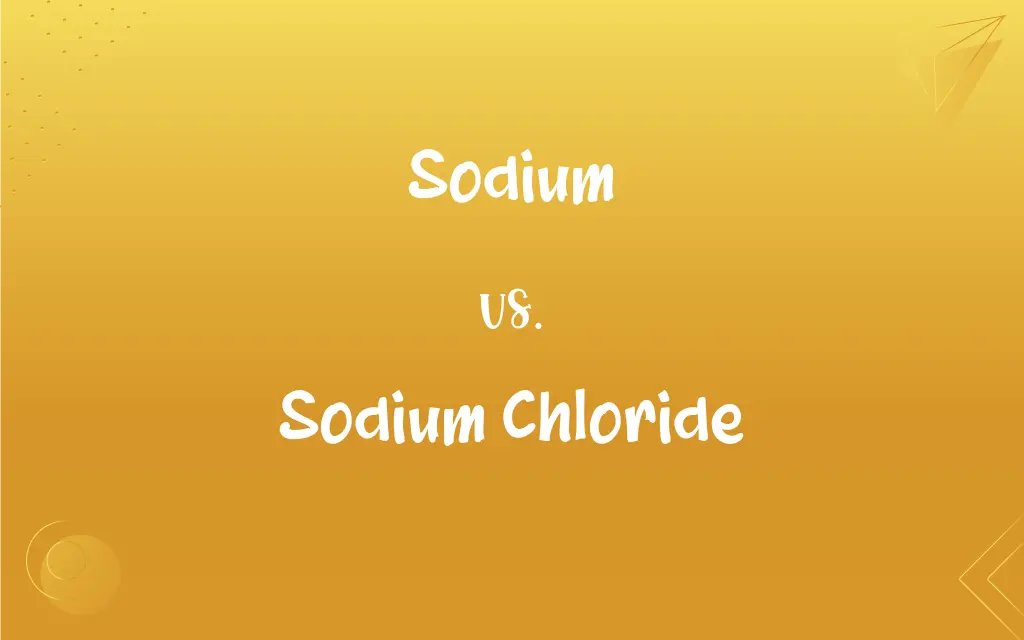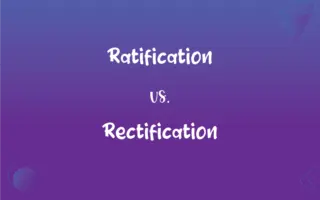Sodium vs. Sodium Chloride: What's the Difference?
By Aimie Carlson & Janet White || Published on July 17, 2024
Sodium is a reactive, soft, silvery-white alkali metal, essential in various industrial processes and biological roles. Sodium chloride is a compound consisting of sodium and chlorine atoms, crucial for human health and widely used in food preservation.

Key Differences
Sodium (Na) is an element found in Group 1 of the periodic table, known for its high reactivity, especially with water, forming sodium hydroxide and hydrogen gas. This reactivity is due to its single electron in the outermost shell, making it highly eager to donate that electron in chemical reactions, a characteristic trait of alkali metals. Sodium plays critical roles in industrial applications, such as in the production of glass, paper, and synthetic rubber, and in biological systems, where it is vital for maintaining cellular function and nerve impulse transmission.
Sodium chloride (NaCl), on the other hand, is a chemical compound that arises from the ionic bond between sodium and chlorine atoms. This bond is formed when sodium donates its valence electron to chlorine, resulting in a stable structure with a characteristic cubic crystal form. Sodium chloride is essential for human health, serving not only as a key electrolyte in bodily fluids but also as a primary source of sodium in the diet. Beyond its dietary importance, sodium chloride is used extensively in food preservation, due to its ability to inhibit the growth of bacteria, and in various industrial processes, including de-icing roads and in the manufacture of chlorine and caustic soda.
The differences between sodium and sodium chloride highlight the transformative nature of chemical bonds: pure sodium is a highly reactive metal, whereas when combined with chlorine to form sodium chloride, the resulting substance is a stable, non-reactive salt that is safe for consumption and has a wide range of applications. This transformation underscores the importance of chemical bonding in altering the properties of elements to create compounds with vastly different characteristics and uses.
Comparison Chart
Nature
Elemental metal
Chemical compound
Physical Properties
Soft, silvery-white, highly reactive
White crystalline solid, non-reactive
ADVERTISEMENT
Chemical Structure
Single atom with one valence electron
Ionic compound formed by Na+ and Cl- ions
Uses
Industrial processes, batteries
Seasoning, food preservation, industrial uses
Biological Role
Nerve impulse transmission, cellular function
Electrolyte balance, osmotic pressure
Reactivity
Reacts violently with water
Stable in water, dissolves into ions
Health Implications
Not directly consumed due to reactivity
Essential for health in moderate amounts
ADVERTISEMENT
Sodium and Sodium Chloride Definitions
Sodium
Stored under oil to prevent reaction with air.
Pure sodium is kept in mineral oil to inhibit oxidation.
Sodium Chloride
Plays a role in the industrial production of chlorine.
Electrolysis of sodium chloride solution produces chlorine gas.
Sodium
Employed in various industrial processes, including glass making.
Sodium carbonate is a key ingredient in glass manufacturing.
Sodium Chloride
Common table salt used for seasoning and preserving food.
Sodium chloride is integral to culinary practices worldwide.
Sodium
A highly reactive alkali metal used in the production of synthetic rubber.
Sodium is crucial in the vulcanization process of rubber.
Sodium Chloride
Utilized in de-icing roads during winter.
Spreading sodium chloride on icy roads lowers the freezing point of water.
Sodium
Essential for nerve impulse transmission in biological systems.
Sodium ions facilitate the electrical signals in neurons.
Sodium Chloride
Acts as an essential electrolyte in the human body.
Sodium chloride helps maintain fluid balance and blood pressure.
Sodium
Used in some types of batteries for energy storage.
Sodium-sulfur batteries are used for grid storage solutions.
Sodium Chloride
Essential in osmotic pressure regulation in cells.
Sodium chloride concentrations affect water movement across cell membranes.
Sodium
A soft, light, extremely malleable silver-white element that is an alkali metal, reacts violently with water, is naturally abundant in combined forms, especially in common salt, and is used in the production of a wide variety of industrially important compounds. Sodium ions are essential to numerous biological processes in animals. Atomic number 11; atomic weight 22.9898; melting point 97.80°C; boiling point 883°C; specific gravity 0.971 (20°C); valence 1. See Periodic Table.
Sodium
The chemical element (symbol Na) with an atomic number of 11 and atomic weight of 22.990. It is a soft, waxy, silvery, reactive alkali metal that is never found unbound in nature.
Sodium
Employing sodium.
Sodium
A common metallic element of the alkali group, in nature always occuring combined, as in common salt, in albite, etc. It is isolated as a soft, waxy, white, unstable metal, so highly reactive that it combines violently with water, and to be preserved must be kept under petroleum or some similar liquid. Sodium is used combined in many salts, in the free state as a reducer, and as a means of obtaining other metals (as magnesium and aluminium) is an important commercial product. Symbol Na (Natrium). Atomic weight 22.990. Specific gravity 0.97.
Sodium
A silvery soft waxy metallic element of the alkali metal group; occurs abundantly in natural compounds (especially in salt water); burns with a yellow flame and reacts violently in water; occurs in sea water and in the mineral halite (rock salt)
FAQs
What are the main uses of sodium chloride besides seasoning?
Beyond seasoning, sodium chloride is used in food preservation, road de-icing, and industrial processes like chlorine production.
What role does sodium play in industrial applications?
Sodium is used in various industrial applications, including as a reducing agent in chemical synthesis and in the manufacture of certain types of glass.
Why is sodium chloride safe to consume, but not sodium?
Sodium chloride is stable and essential for bodily functions, whereas pure sodium is highly reactive and can cause harm upon contact with moisture, including in the human body.
Why is sodium chloride used in food preservation?
Sodium chloride inhibits the growth of bacteria by creating a hostile environment for microbial activity, thus preserving food.
Can sodium exist naturally in its elemental form?
Due to its reactivity, sodium rarely exists in its elemental form in nature and is typically found in compounds like sodium chloride.
How do industries handle the reactivity of sodium?
Industries handle sodium's reactivity by storing it under inert conditions, such as submerged in mineral oil, to prevent accidental reactions.
How does sodium function in the human body?
Sodium plays a crucial role in nerve impulse transmission, muscle contraction, and maintaining fluid balance.
What is the key difference between sodium and sodium chloride?
Sodium is a reactive alkali metal, while sodium chloride is a stable compound formed from sodium and chlorine.
How is sodium chloride produced for consumption?
Sodium chloride for consumption is either mined from salt deposits as rock salt or obtained by evaporating seawater, followed by purification processes.
What happens when sodium reacts with water?
Sodium reacts violently with water, producing sodium hydroxide and hydrogen gas, often accompanied by heat and sometimes fire.
How does the body regulate sodium and sodium chloride levels?
The body regulates sodium and sodium chloride levels through the kidneys, which filter excess sodium into the urine, and through hormonal mechanisms that adjust sodium retention and water balance.
Can sodium chloride be used in medical applications?
Yes, sodium chloride is used in medical applications, including intravenous saline solutions for hydration and electrolyte balance, and in nasal sprays to alleviate congestion.
Why is pure sodium stored under oil?
Pure sodium is stored under oil to prevent it from reacting with moisture in the air or oxygen, which could lead to oxidation or a potentially explosive reaction with water.
What environmental impacts can be associated with sodium chloride?
The widespread use of sodium chloride for road de-icing can lead to environmental impacts, including soil and water contamination, toxicity to aquatic life, and corrosion of vehicles and infrastructure.
How is sodium chloride essential for nerve function?
Sodium chloride is essential for nerve function as it facilitates the generation and transmission of electrical signals in neurons through the movement of sodium ions across cell membranes.
What is the significance of the ionic bond in sodium chloride?
The ionic bond in sodium chloride, formed when sodium donates its outer electron to chlorine, results in a stable compound with distinct properties from its constituent elements, such as high melting point and solubility in water.
Are there sustainable alternatives to using sodium chloride for road de-icing?
Sustainable alternatives for road de-icing include the use of brine solutions, which require less salt, and environmentally friendly materials like beet juice, cheese brine, or coffee grounds mixed with salt, which can reduce the amount of chloride entering the environment.
Is there a health risk associated with consuming too much sodium chloride?
Yes, excessive consumption of sodium chloride can lead to health issues such as hypertension (high blood pressure), heart disease, and stroke due to its effect on fluid balance and blood pressure.
What is the role of sodium in energy storage technologies?
Sodium is explored in energy storage technologies, such as sodium-ion batteries, due to its abundance, low cost, and favorable electrochemical properties for rechargeable battery applications.
How do sodium and sodium chloride interact with water differently?
Sodium reacts violently with water, producing heat and hydrogen gas, while sodium chloride simply dissolves in water, dissociating into sodium and chloride ions without a chemical reaction.
About Author
Written by
Aimie CarlsonAimie Carlson, holding a master's degree in English literature, is a fervent English language enthusiast. She lends her writing talents to Difference Wiki, a prominent website that specializes in comparisons, offering readers insightful analyses that both captivate and inform.
Co-written by
Janet WhiteJanet White has been an esteemed writer and blogger for Difference Wiki. Holding a Master's degree in Science and Medical Journalism from the prestigious Boston University, she has consistently demonstrated her expertise and passion for her field. When she's not immersed in her work, Janet relishes her time exercising, delving into a good book, and cherishing moments with friends and family.






































































